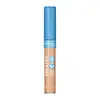What's inside
What's inside
 Key Ingredients
Key Ingredients

 Benefits
Benefits

 Concerns
Concerns

 Ingredients Side-by-side
Ingredients Side-by-side

Water
Skin ConditioningDimethicone
EmollientGlycerin
HumectantNeopentyl Glycol Dicaprylate/Dicaprate
EmollientCyclopentasiloxane
EmollientHydrogenated Polydecene
EmollientPEG-9 Polydimethylsiloxyethyl Dimethicone
EmulsifyingPhenyl Trimethicone
Skin ConditioningMethyl Methacrylate Crosspolymer
Sodium Chloride
MaskingPropanediol
SolventTocopheryl Acetate
AntioxidantSodium Hyaluronate
HumectantTocopherol
AntioxidantDimethicone/PEG-10/15 Crosspolymer
Disteardimonium Hectorite
StabilisingPolysorbate 20
EmulsifyingEthylhexylglycerin
Skin ConditioningDimethicone Crosspolymer
Emulsion StabilisingSodium Levulinate
Skin ConditioningAcmella Oleracea Extract
Skin ProtectingPropylene Carbonate
SolventXanthan Gum
EmulsifyingTriethoxycaprylylsilane
Dipropylene Glycol
HumectantCitric Acid
BufferingSodium Citrate
BufferingPotassium Sorbate
PreservativeCI 77491
Cosmetic ColorantCI 77492
Cosmetic ColorantCI 77499
Cosmetic ColorantCI 77891
Cosmetic ColorantWater, Dimethicone, Glycerin, Neopentyl Glycol Dicaprylate/Dicaprate, Cyclopentasiloxane, Hydrogenated Polydecene, PEG-9 Polydimethylsiloxyethyl Dimethicone, Phenyl Trimethicone, Methyl Methacrylate Crosspolymer, Sodium Chloride, Propanediol, Tocopheryl Acetate, Sodium Hyaluronate, Tocopherol, Dimethicone/PEG-10/15 Crosspolymer, Disteardimonium Hectorite, Polysorbate 20, Ethylhexylglycerin, Dimethicone Crosspolymer, Sodium Levulinate, Acmella Oleracea Extract, Propylene Carbonate, Xanthan Gum, Triethoxycaprylylsilane, Dipropylene Glycol, Citric Acid, Sodium Citrate, Potassium Sorbate, CI 77491, CI 77492, CI 77499, CI 77891
Water
Skin ConditioningDicaprylyl Carbonate
EmollientDicaprylyl Ether
EmollientAluminum Starch Octenylsuccinate
AbsorbentGlycerin
HumectantTrimethylsiloxysilicate
EmollientSodium Chloride
MaskingTri (Polyglyceryl-3/Lauryl) Hydrogenated Trilinoleate
EmulsifyingSilica
AbrasiveStearalkonium Bentonite
Gel FormingCetyl PEG/PPG-10/1 Dimethicone
EmulsifyingMica
Cosmetic ColorantPropylene Carbonate
SolventTocopherol
AntioxidantPanthenol
Skin ConditioningTriethoxycaprylylsilane
Sodium Benzoate
MaskingChlorphenesin
AntimicrobialAloe Barbadensis Leaf Juice
Skin ConditioningMethicone
EmollientPantolactone
HumectantPentaerythrityl Tetra-Di-T-Butyl Hydroxyhydrocinnamate
AntioxidantCI 77891
Cosmetic ColorantIron Oxides
Water, Dicaprylyl Carbonate, Dicaprylyl Ether, Aluminum Starch Octenylsuccinate, Glycerin, Trimethylsiloxysilicate, Sodium Chloride, Tri (Polyglyceryl-3/Lauryl) Hydrogenated Trilinoleate, Silica, Stearalkonium Bentonite, Cetyl PEG/PPG-10/1 Dimethicone, Mica, Propylene Carbonate, Tocopherol, Panthenol, Triethoxycaprylylsilane, Sodium Benzoate, Chlorphenesin, Aloe Barbadensis Leaf Juice, Methicone, Pantolactone, Pentaerythrityl Tetra-Di-T-Butyl Hydroxyhydrocinnamate, CI 77891, Iron Oxides
 Reviews
Reviews

Ingredients Explained
These ingredients are found in both products.
Ingredients higher up in an ingredient list are typically present in a larger amount.
Ci 77891 is a white pigment from Titanium dioxide. It is naturally found in minerals such as rutile and ilmenite.
It's main function is to add a white color to cosmetics. It can also be mixed with other colors to create different shades.
Ci 77891 is commonly found in sunscreens due to its ability to block UV rays.
Learn more about CI 77891Glycerin is already naturally found in your skin. It helps moisturize and protect your skin.
A study from 2016 found glycerin to be more effective as a humectant than AHAs and hyaluronic acid.
As a humectant, it helps the skin stay hydrated by pulling moisture to your skin. The low molecular weight of glycerin allows it to pull moisture into the deeper layers of your skin.
Hydrated skin improves your skin barrier; Your skin barrier helps protect against irritants and bacteria.
Glycerin has also been found to have antimicrobial and antiviral properties. Due to these properties, glycerin is often used in wound and burn treatments.
In cosmetics, glycerin is usually derived from plants such as soybean or palm. However, it can also be sourced from animals, such as tallow or animal fat.
This ingredient is organic, colorless, odorless, and non-toxic.
Glycerin is the name for this ingredient in American English. British English uses Glycerol/Glycerine.
Learn more about GlycerinThis ingredient is a solvent. It helps dissolve active ingredients and alter the texture of products.
Propylene Carbonate is commonly used in makeup and with clay, such as montmorillonite or bentonite.
Studies show this ingredient to be safe for cosmetics. When it is undiluted, it can cause skin irritation. (It is always diluted in skincare and makeup). This ingredient is water-soluble.
Propylene Carbonate is created from propylene glycol and carbonic acid.
Learn more about Propylene CarbonateChances are, you eat sodium chloride every day. Sodium Chloride is also known as table salt.
This ingredient has many purposes in skincare: thickener, emulsifier, and exfoliator.
You'll most likely find this ingredient in cleansers where it is used to create a gel-like texture. As an emulsifier, it also prevents ingredients from separating.
There is much debate on whether this ingredient is comedogenic. The short answer - comedogenic ratings don't tell the whole story. Learn more about comegodenic ratings here.
The concensus about this ingredient causing acne seems to be divided. Research is needed to understand if this ingredient does cause acne.
Scrubs may use salt as the primary exfoliating ingredient.
Learn more about Sodium ChlorideTocopherol (also known as Vitamin E) is a common antioxidant used to help protect the skin from free-radicals and strengthen the skin barrier. It's also fat soluble - this means our skin is great at absorbing it.
Vitamin E also helps keep your natural skin lipids healthy. Your lipid skin barrier naturally consists of lipids, ceramides, and fatty acids. Vitamin E offers extra protection for your skin’s lipid barrier, keeping your skin healthy and nourished.
Another benefit is a bit of UV protection. Vitamin E helps reduce the damage caused by UVB rays. (It should not replace your sunscreen). Combining it with Vitamin C can decrease sunburned cells and hyperpigmentation after UV exposure.
You might have noticed Vitamin E + C often paired together. This is because it is great at stabilizing Vitamin C. Using the two together helps increase the effectiveness of both ingredients.
There are often claims that Vitamin E can reduce/prevent scarring, but these claims haven't been confirmed by scientific research.
Learn more about TocopherolTriethoxycaprylylsilane is a silicone used to bind and stabilize ingredients.
As an emulsifier, it helps prevent ingredients from separating. This can help elongate the shelf life of products.
Triethoxycaprylylsilane is often used to coat mineral sunscreens ingredients to help give a better feel. It also helps reduce oxidative stress in sunscreens.
Learn more about TriethoxycaprylylsilaneWater. It's the most common cosmetic ingredient of all. You'll usually see it at the top of ingredient lists, meaning that it makes up the largest part of the product.
So why is it so popular? Water most often acts as a solvent - this means that it helps dissolve other ingredients into the formulation.
You'll also recognize water as that liquid we all need to stay alive. If you see this, drink a glass of water. Stay hydrated!
Learn more about Water